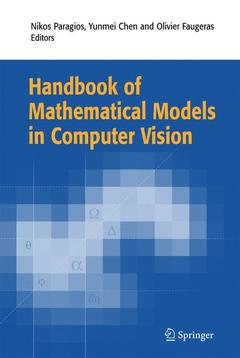Handbook of Mathematical Models in Computer Vision, Softcover reprint of hardcover 1st ed. 2006
Langue : Anglais
Coordonnateurs : Paragios Nikos, Chen Yunmei, Faugeras Olivier D.

Abstract Biological vision is a rather fascinating domain of research. Scientists of various origins like biology, medicine, neurophysiology, engineering, math ematics, etc. aim to understand the processes leading to visual perception process and at reproducing such systems. Understanding the environment is most of the time done through visual perception which appears to be one of the most fundamental sensory abilities in humans and therefore a significant amount of research effort has been dedicated towards modelling and repro ducing human visual abilities. Mathematical methods play a central role in this endeavour. Introduction David Marr's theory v^as a pioneering step tov^ards understanding visual percep tion. In his view human vision was based on a complete surface reconstruction of the environment that was then used to address visual subtasks. This approach was proven to be insufficient by neuro-biologists and complementary ideas from statistical pattern recognition and artificial intelligence were introduced to bet ter address the visual perception problem. In this framework visual perception is represented by a set of actions and rules connecting these actions. The emerg ing concept of active vision consists of a selective visual perception paradigm that is basically equivalent to recovering from the environment the minimal piece information required to address a particular task of interest.
Image Reconstruction.- Diffusion Filters and Wavelets: What Can They Learn from Each Other?.- Total Variation Image Restoration: Overview and Recent Developments.- PDE-Based Image and Surface Inpainting.- Boundary Exraction, Segmentation and Grouping.- Levelings: Theory and Practice.- Graph Cuts in Vision and Graphics: Theories and Applications.- Minimal Paths and Fast Marching Methods for Image Analysis.- Integrating Shape and Texture in DeformabIe Models: from Hybrid Methods to Metamorphs.- Variational Segmentation with Shape Priors.- Curve Propagation, Level Set Methods and Grouping.- On a Stochastic Model of Geometric Snakes.- Shape Modeling & Registration.- Invariant Processing and Occlusion Resistant Recognition of Planar Shapes.- Planar Shape Analysis and Its Applications in Image-Based Inferences.- Diffeomorphic Point Matching.- Uncertainty-Driven, Point-Based Image Registration.- Motion Analysis, Optical Flow & Tracking.- Optical Flow Estimation.- From Bayes to PDEs in Image Warping.- Image Alignment and Stitching.- Visual Tracking: A Short Research Roadmap.- Shape Gradient for Image and Video Segmentation.- Model-Based Human Motion Capture.- Modeling Dynamic Scenes: An Overview of Dynamic Textures.- 3D from Images, Projective Geometry & Stereo Reconstruction.- Differential Geometry from the Frenet Point of View: Boundary Detection, Stereo, Texture and Color.- Shape From Shading.- 3D from Image Sequences: Calibration, Motion and Shape Recovery.- Multi-view Reconstruction of Static and Dynamic Scenes.- Graph Cut Algorithms for Binocular Stereo with Occlusions.- Modelling Non-Rigid Dynamic Scenes from Multi-View Image Sequences.- Applications: Medical Image Analysis.- Interactive Graph-Based Segmentation Methods in Cardiovascular Imaging.- 3D Active Shape and Appearance Models in Cardiac Image Analysis.- Characterization of Diffusion Anisotropy in DWI.- Segmentation of Diffusion Tensor Images.- Variational Approaches to the Estimation, Regularizatinn and Segmentation of Diffusion Tensor Images.- An Introduction to Statistical Methods of Medical Image Registration.
The most comprehensive, up-to-date treatment of computational vision topics Six thematic areas provide answers to the most dominant questions of computational vision
Date de parution : 10-2010
Ouvrage de 606 p.
15.5x23.5 cm
Date de parution : 10-2005
Ouvrage de 606 p.
15.6x23.5 cm
Thèmes de Handbook of Mathematical Models in Computer Vision :
Mots-clés :
3D; 3D graphics; Alignment; Analysis; STATISTICA; Stereo; algorithms; computer; image analysis; image processing; model; modeling; shading
© 2024 LAVOISIER S.A.S.
